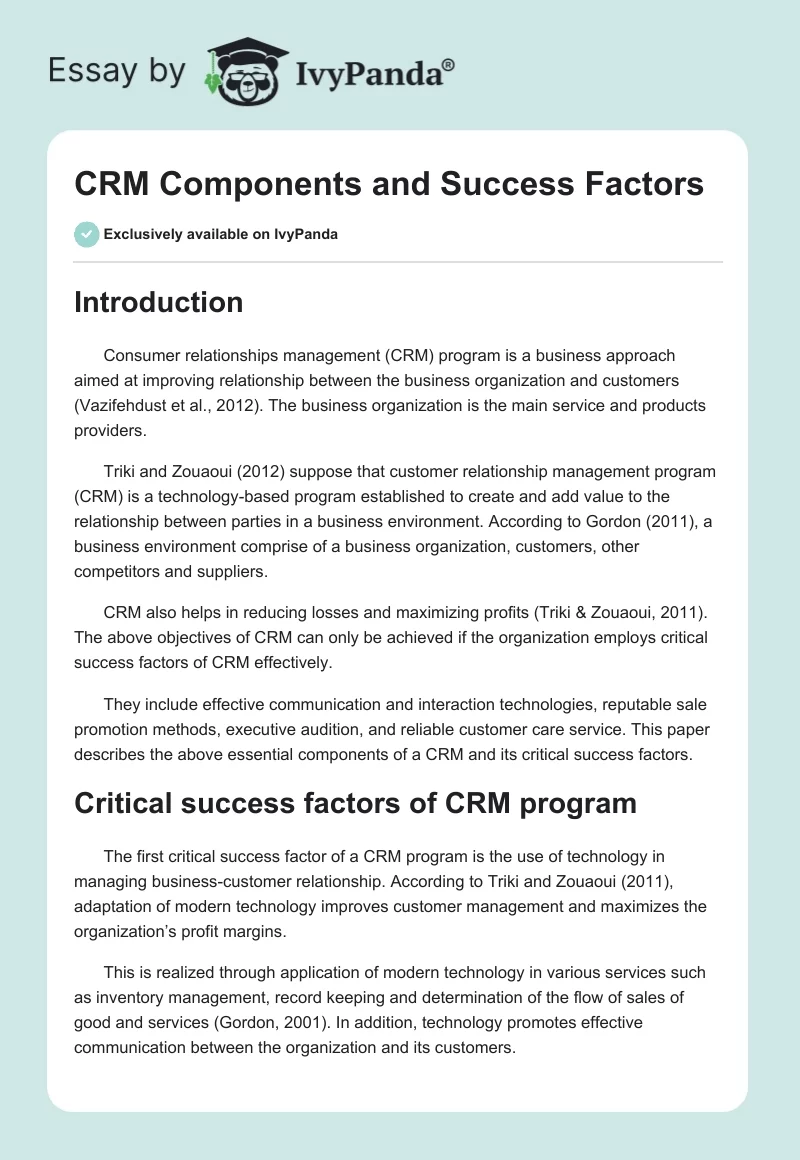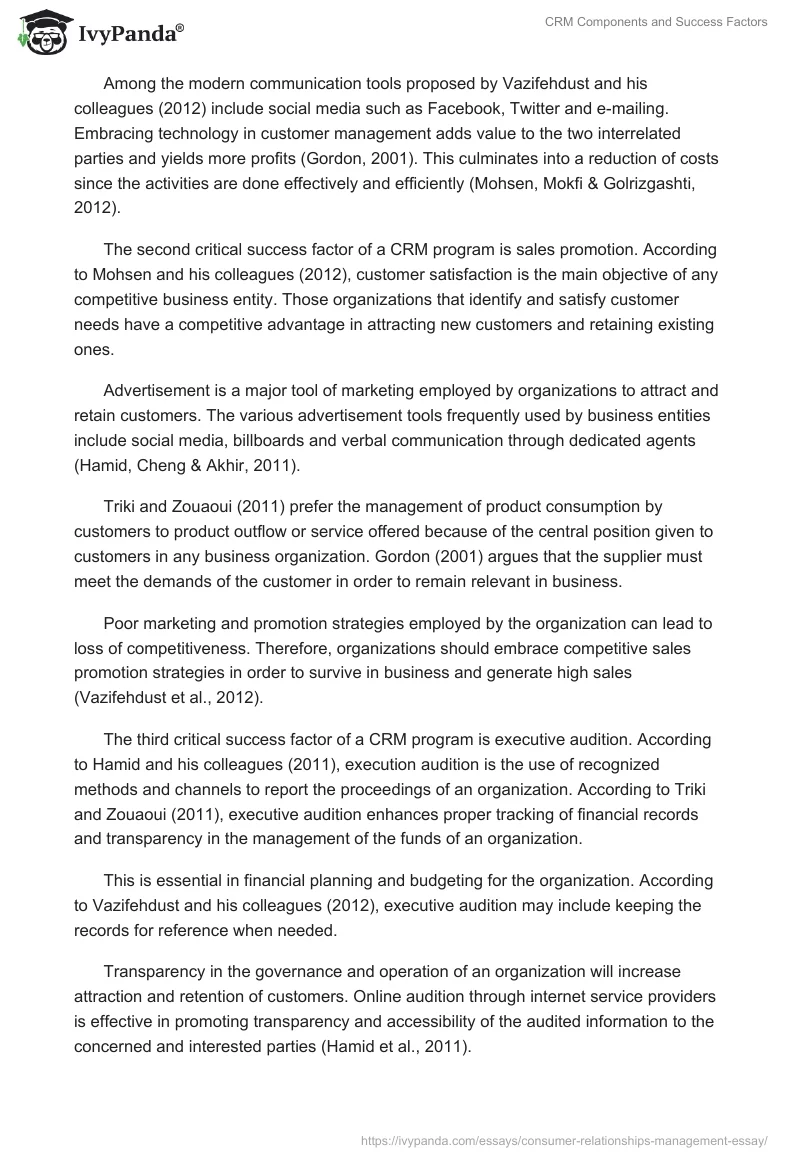Introduction
Consumer relationships management (CRM) program is a business approach aimed at improving relationship between the business organization and customers (Vazifehdust et al., 2012). The business organization is the main service and products providers.
Triki and Zouaoui (2012) suppose that customer relationship management program (CRM) is a technology-based program established to create and add value to the relationship between parties in a business environment. According to Gordon (2011), a business environment comprise of a business organization, customers, other competitors and suppliers.
CRM also helps in reducing losses and maximizing profits (Triki & Zouaoui, 2011). The above objectives of CRM can only be achieved if the organization employs critical success factors of CRM effectively.
They include effective communication and interaction technologies, reputable sale promotion methods, executive audition, and reliable customer care service. This paper describes the above essential components of a CRM and its critical success factors.
Critical success factors of CRM program
The first critical success factor of a CRM program is the use of technology in managing business-customer relationship. According to Triki and Zouaoui (2011), adaptation of modern technology improves customer management and maximizes the organization’s profit margins.
This is realized through application of modern technology in various services such as inventory management, record keeping and determination of the flow of sales of good and services (Gordon, 2001). In addition, technology promotes effective communication between the organization and its customers.
Among the modern communication tools proposed by Vazifehdust and his colleagues (2012) include social media such as Facebook, Twitter and e-mailing. Embracing technology in customer management adds value to the two interrelated parties and yields more profits (Gordon, 2001). This culminates into a reduction of costs since the activities are done effectively and efficiently (Mohsen, Mokfi & Golrizgashti, 2012).
The second critical success factor of a CRM program is sales promotion. According to Mohsen and his colleagues (2012), customer satisfaction is the main objective of any competitive business entity. Those organizations that identify and satisfy customer needs have a competitive advantage in attracting new customers and retaining existing ones.
Advertisement is a major tool of marketing employed by organizations to attract and retain customers. The various advertisement tools frequently used by business entities include social media, billboards and verbal communication through dedicated agents (Hamid, Cheng & Akhir, 2011).
Triki and Zouaoui (2011) prefer the management of product consumption by customers to product outflow or service offered because of the central position given to customers in any business organization. Gordon (2001) argues that the supplier must meet the demands of the customer in order to remain relevant in business.
Poor marketing and promotion strategies employed by the organization can lead to loss of competitiveness. Therefore, organizations should embrace competitive sales promotion strategies in order to survive in business and generate high sales (Vazifehdust et al., 2012).
The third critical success factor of a CRM program is executive audition. According to Hamid and his colleagues (2011), execution audition is the use of recognized methods and channels to report the proceedings of an organization. According to Triki and Zouaoui (2011), executive audition enhances proper tracking of financial records and transparency in the management of the funds of an organization.
This is essential in financial planning and budgeting for the organization. According to Vazifehdust and his colleagues (2012), executive audition may include keeping the records for reference when needed.
Transparency in the governance and operation of an organization will increase attraction and retention of customers. Online audition through internet service providers is effective in promoting transparency and accessibility of the audited information to the concerned and interested parties (Hamid et al., 2011).
The fourth critical success factor of a CRM program is customer care service instituted to maintain and improve the contact between the customer and the products (Vazifehdust et al., 2012). Triki and Zouaoui (2011) argue that the survival of business organizations depend on the willingness of customers to buy their products. Therefore, service providers should strive to understand customers’ needs and meet them effectively.
This knowledge of customer needs works hand-in-hand with a CRM program to initiate good rapport between the organization and the customer in question (Mohsen et al., 2012). Customer service provides all information regarding organizational products and services.
Customer care service also includes sales analysis. Analysis of business performance of the organization through customer feedback is essential in identifying changes and new business strategies. Customer feedbacks are used as strategic tools towards improving customer service design and delivery. As suggested by Nguyen (2012), a good customer-firm relationship is built on four pillars.
That is, trust and commitment, satisfaction, beneficial inter-dependence and fairness. Trust and commitment is a business bond between an organization and the customers. Customers will consume goods and services from a provider who is committed in meeting their needs. Service provider’s commitment promotes trust between him and customers.
Conclusion
In summary, customer relationship management program is focused on customer satisfaction. Effective provision of products and services that meet customer needs increases organizational returns. The loyalty of customers should also be monitored by offering better incentives as they can be lured easily by the organizational competitors (Nguyen, 2012).
A CRM program is a dynamic program and therefore needs to be regularly updated through pragmatic approaches. The critical success factors described in this paper include the use of modern communication technologies to enhance the relationship between the organization and customers, sales promotion, executive audition and customer care service.
References
Gordon, I., 2001, ‘Crm Is A Strategy Not A Tactic: Improving the practice of management’, Ivey business Journal, 66.1, pp. 6-8.
Greenberg, P. 2010, CRM at the speed of light social CRM strategies, tools, and techniques for engaging your customers. McGraw-Hill, New York.
Hamid, N. Cheng, A. and Akhir, R., 2011, ‘Dimensions of E-CRM: An Empirical Study on Hotels Web Sites’, Journal of Southeast Asian Research. Web.
Mohsen, M. Mokfi, T. and Golrizgashti, S. (2012) ‘Proposing a customer knowledge management model for customer value augmentation: A home appliances case study’, Journal of Database Marketing & Customer Strategy Management, 19, pp.321-347.
Nguyen, B. (2012) ‘The dark side of the customer relationship management: Exploring the underlying reasons for pitfalls, exploitation and unfairness’, Journal of Database Marketing & Customer Strategy Management, 5.19, pp. 56-70.
Triki, A. and Zouaoui, F. (2011) ‘Customer Knowledge Management Competencies Role in the CRM Implementation Project’, Journal of Organizational Knowledge Management. Web.
Vazifehdust, H., Shahnavazi, A., Jourshari, R. and Sharifi, S. (2012) ‘Investigation Critical Success Factors of Customer Relationship Management Implementation’, World Applied Sciences Journal, 18.8, pp. 1052-1061.


